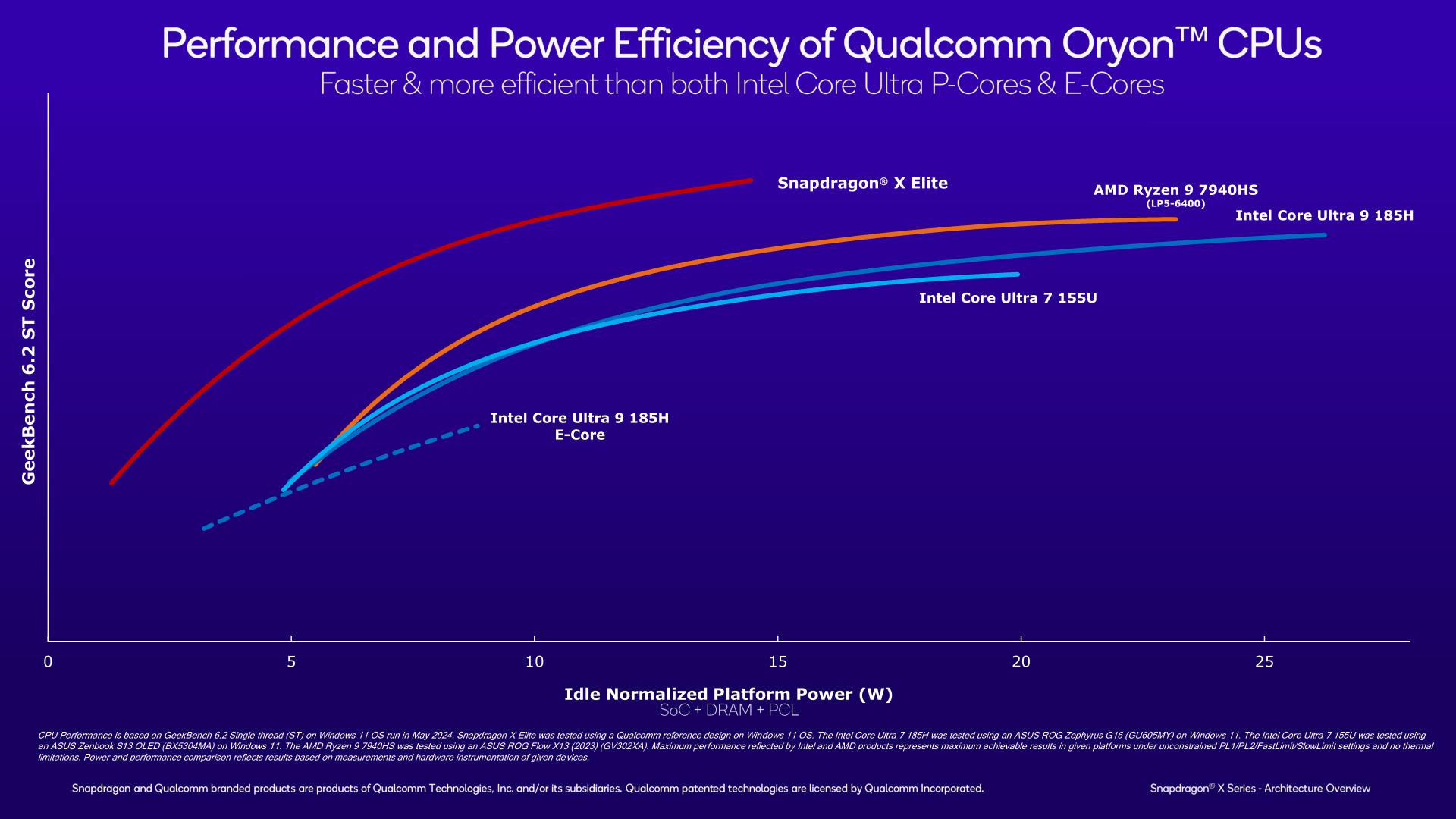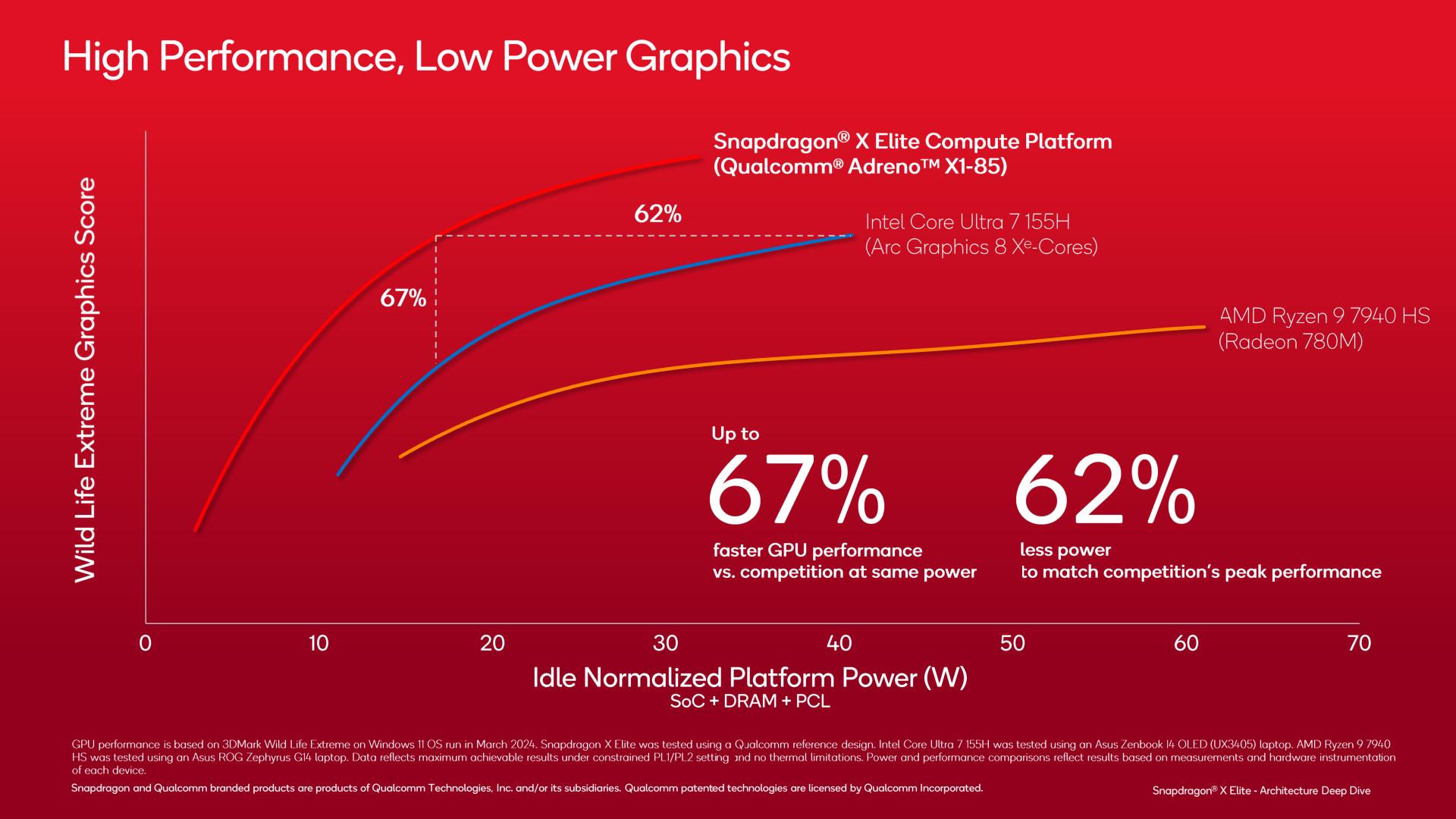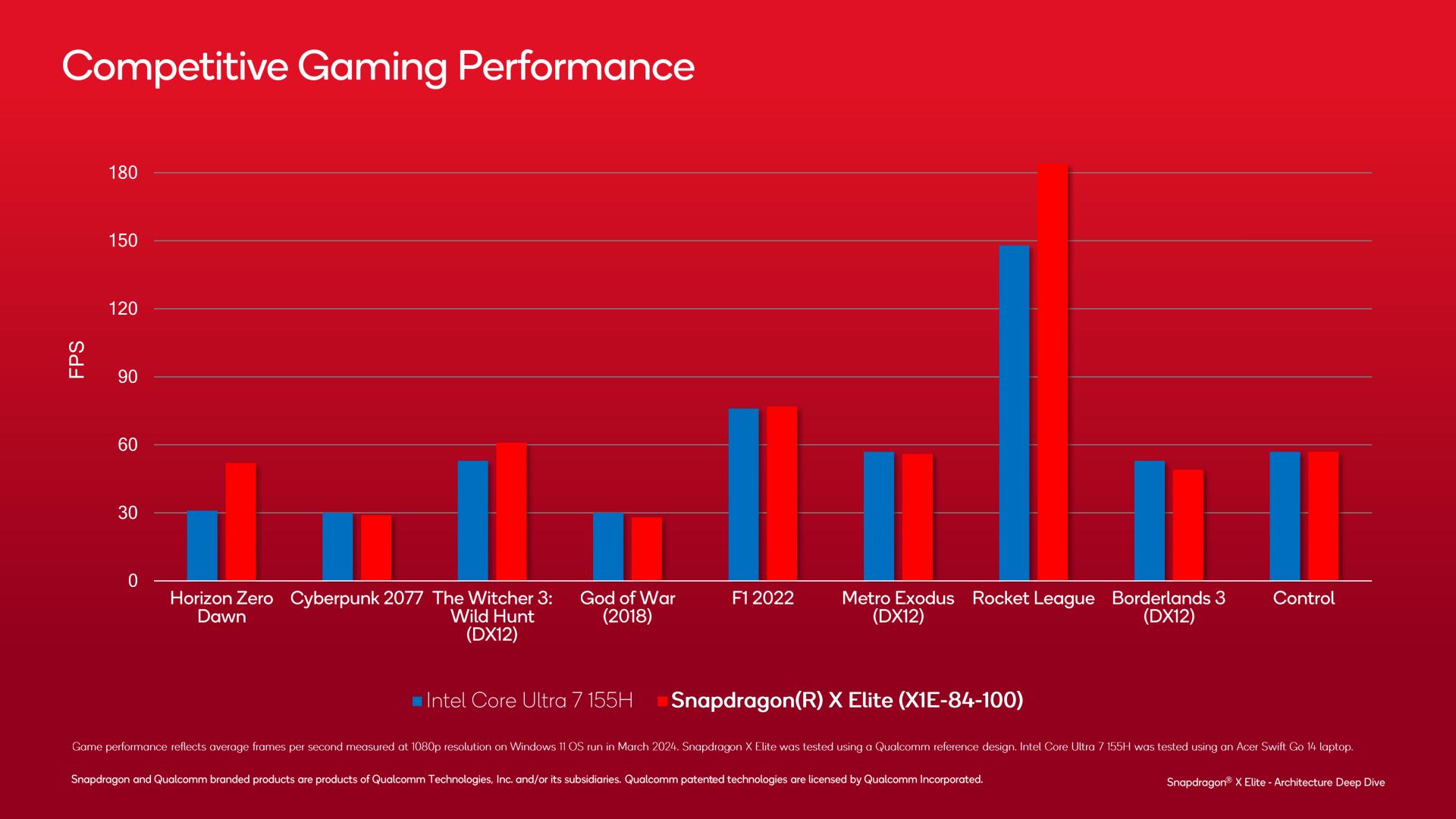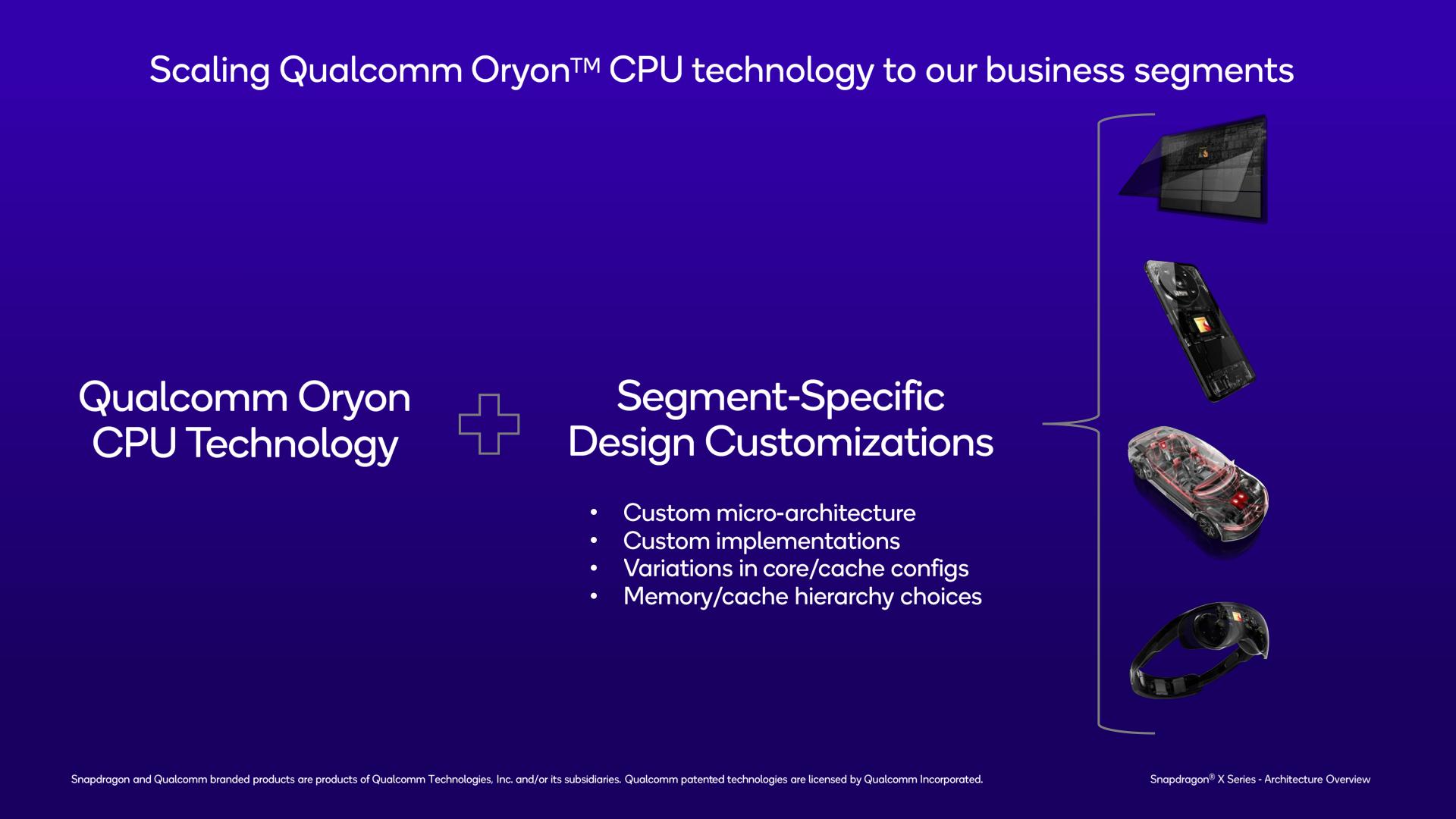The Qualcomm Snapdragon X Architecture Deep Dive: Getting To Know Oryon and Adreno X1
by Ryan Smith on June 13, 2024 9:00 AM ESTPerformance Promises and First Thoughts
Wrapping things up, let’s touch upon a couple of Qualcomm’s performance slides before closing out this architectural deep dive. While the whole world will get to see what the Snapdragon X can do first-hand next week when retail devices launch, until then it gives us a bit more insight into what to expect. Just be sure to take it with the requisite grain of salt.
On the CPU side of matters, Qualcomm is claiming that the Snapdragon X Elite can beat the entire field of contemporary PC competitors in GeekBench 6.2 single-threading. And by a significant degree, too, when power efficiency is taken into account.
In short, Qualcomm claims that the Oryon CPU core in the Snapdragon X Elite can beat both Redwood Cove (Meteor Lake) and Zen 4 (Phoenix) in absolute performance, even if the x86 cores are allowed unrestricted TDPs. With mobile x86 chips turboing as high as 5GHz it’s a bold claim, but not out of the realm of possibility.
Meanwhile on the GPU front, Qualcomm is making similar energy efficiency gains. Though the workload in question – 3DMark WildLife Extreme – is not likely to translate into most games, as this is a mobile-focused benchmark that has long been optimized to heck and back within every mobile SoC vendor’s drivers.
Performance benchmarks using actual games are arguably more useful here. And even though Qualcomm is probably doing some cherry-picking, the top Snapdragon X SKU is often trading blows with Intel’s Core Ultra 7 155H. It admittedly makes for a less impressive showing overall, but it’s good to see where Qualcomm is currently landing on real games. And in this case, even just a mix of ties/beats of one of Intel’s better mobile chips is not a bad showing.
First Thoughts
And there you have it, our first deep dive into a Qualcomm Snapdragon X SoC architecture. With Qualcomm investing into the Windows-on-Arm ecosystem for the long haul, this will hopefully be the first of many, as the company seeks to become the third major Windows CPU/SoC vendor.
But the ultimate significance of the Snapdragon X SoC and its Oryon CPU cores goes beyond just mere SoCs for PC laptops. Even if Qualcomm is wildly successful here, the number of PC chips they’ll ship will be a drop in the bucket compared to their true power base: the Android SoC space. And this is where Oryon is going to be lighting the way to some significant changes for Qualcomm’s mobile SoCs.
As noted by Qualcomm since the start of their Oryon journey, this is ultimately the CPU core that will be at the heart of all of Qualcomm’s products. What starts this month with PC SoCs will eventually grow to include mobile SoCs like the Snapdragon 8 series, and farther along still will be Qualcomm’s automotive products, and high-end offshoots like their XR headset SoCs. And while I doubt we’ll really see Oryon and its successors in Qualcomm’s product in a true top-to-bottom fashion (the company needs small and cheap CPU cores for their budget lines like Snapdragon 6 and Snapdragon 4), there is no doubt that it’s going to become a cornerstone of most of their products over the long run. That’s the value of differentiation of making your own CPU core – and getting the most value out of that CPU core by using it in as many places as possible.
Ultimately, Qualcomm has spent the last 8 months hyping up their next-generation PC SoC and its bespoke CPU core, and now it’s time for all of the pieces to fall into place. The prospect of having a third competitor in the PC CPU space – and an Arm-baesd one at that – is exciting, but slideware and advertising aren’t hardware and benchmarks. So we’re eagerly awaiting what next week will bring, and seeing if Qualcomm’s engineering prowess can live up to the company’s grand ambitions.




















52 Comments
View All Comments
meacupla - Friday, June 14, 2024 - link
It looks like the laptop is stuck at 2.5Ghz, and can't boost to 4.0Ghz for whatever reason. Replyshabby - Friday, June 14, 2024 - link
Reason is probably heat so it's neutered. Replymeacupla - Friday, June 14, 2024 - link
I think that article is there just for clicks. You are aware the source of those benches got the galaxybook working at 4ghz, right? Replydada_dave - Friday, June 14, 2024 - link
It's not "yellow journalism" or "clickbait" to report on a real phenomenon affecting Lenovo, Asus, and Samsung models (https://browser.geekbench.com/search?utf8=✓&q=snapdragon+x+elite) while telling people to hold their pitchforks because it's probably fixable. In fact it's good to report on it so if the problem persists during launch and a user does get an affected model they can look up what's happening and instead of the first thing they find is "Qualcomm LIED!" they see a tech outlet saying this may be a fixable problem. At this point we don't even know the cause, except that it is widespread but temperamental, pointing to a likely firmware culprit. ReplyFWhitTrampoline - Thursday, June 13, 2024 - link
I'm Impressed that Qualcomm was this forthcoming with their CPU core, and iGPU core, information as most do not even provide a fraction of the CPU core information like Instruction Decoders Width and Micro-Op instruction issue and instruction retirement rates per cycle. And the Adreno X1's proper Render Configuration is able to be established Shaders:TMUs:ROPs from that material that Qualcomm provided. That's a proper Qualcomm information reveal just like Intel did for its Lunar lake SOCs and AMD should be ashamed of themselves for that Computex event and AMD more like Apple there and no proper Zen-5 CPU core Block diagrams or much any other relevant information like AMD has provided in the past! I guess AMD's saving all the details for Zen-5 for Hot Chips but really AMD's just gone downhill for proper release information info and Whitepaper releases.There is very little of that Marketing material here and some very salient technical details provided as far as I'm concerned. And Marketing does tend to get themselves too much in the way for what should be the technical aspects focused presentation of CPUs and GPUs! Reply
Dante Verizon - Thursday, June 13, 2024 - link
I prefer benchmarks a million times more than a bunch of marketing slides from intel or qualcomm... jez ReplyFWhitTrampoline - Friday, June 14, 2024 - link
CPU block diagrams and GPU block diagrams and other in-depth descriptions like is presented here are not marketing slides in my world and all Benchmarks Can be gamed to some degree and by marketing departments and so it's all the same there. And Qualcomm and Intel's latest materials were more towards the Hot Chips symposium sorts of academic presentations rather than the AMD/Apple sorts of Magic Black box presentations sans any proper whitepaper publication at all. As far as Benchmarks that's a lot of different review sights for Benchmarks because invariably a single website will not cover all the bases there.And If you do not Like the "Marketing Slides" then skip that and wait for the benchmarks so why have any need to read, and comment about, what you have stated you are not interested in to begin with!
Reply
tkSteveFOX - Sunday, June 16, 2024 - link
Same here. Nothing brings me confidence except the battery life claims. These are legit. Performance and compatibility claims to me look very exaggerated. It's going to take a full iteration of Windows (12) to make the promises closer to reality. Replykpb321 - Thursday, June 13, 2024 - link
On the end of page one: "Microsoft, for its part, has continued to work on their x86/x86 emulation layer, which now goes by the name Prism"I assume this should be x86/x64 or something like that as x86 twice doesn't make sense. Reply
GeoffreyA - Thursday, June 13, 2024 - link
The Oryon core's microarchitecture sounds quite meaty indeed. Reply